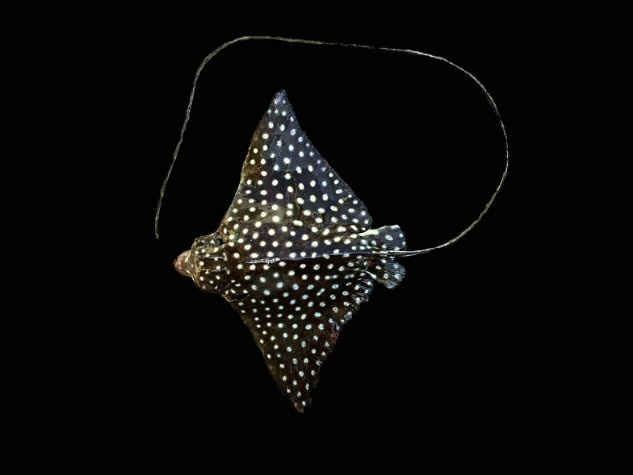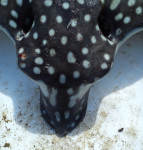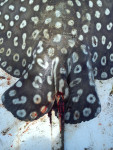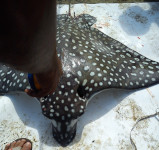Aetobatus laticeps
(Gill, 1865)
Pacific whitespotted eagle ray
Classification: Elasmobranchii Myliobatiformes Aetobatidae
Reference of the original description
Note on the family of myliobatoids, and on a new species of Aetobatis. Annals of the Lyceum of Natural History of New York, 8(13), 135–138
Note on the family of myliobatoids, and on a new species of Aetobatis. Annals of the Lyceum of Natural History of New York, 8(13), 135–138
Image of the original description
No image in first description.
No image in first description.
Synonyms / new combinations and misspellings
Aetobatis laticeps, Stoasodon laticeps
Aetobatis laticeps, Stoasodon laticeps
Description :
Citation: Aetobatus laticeps (Gill, 1865): In: Database of modern sharks, rays and chimaeras, www.shark-references.com, World Wide Web electronic publication, Version 12/2025
Please send your images of "Aetobatus laticeps" to info@shark-references.com

Aetobatus laticeps (Euphrasen, 1790), © Centro Interdisciplinario de Ciencias Marinas (CICIMAR-IPN) http://coleccion.cicimar.ipn.mx

Aetobatus laticeps (Euphrasen, 1790), © Centro Interdisciplinario de Ciencias Marinas (CICIMAR-IPN) http://coleccion.cicimar.ipn.mx
Common names
Pacific whitespotted eagle ray
Pacific whitespotted eagle ray
Short Description
Diagnosis after GILL, 1865 [3582]: The greatest width is rather more than twice as great as the distance from the snout to the front of anus. The head is rather broad and nearly equals the distance from the snout to the division between the nasal lobes. The snout is obtusely angulated in front, and at its sides is convex and scarcely angulated ; its width, at the line of the front of the nostril, is as great as the distance from its point to the interlobular nasal emargination. The rostro-frontal fontanelle is constricted at its anterior third ; the interval between the crests of the anterior portion enters about 2 2/3 times in the interorbital area ; at the constriction, about four times, and at the posterior portion, about 2 2/3 times ; the posterior portion gradually expands backwards and terminates with an oval contour behind. The nasal lobes are about twice as long as wide, their length externally exceeding half the length or breadth of the rostral area. The dental plate has a triangular contour ; its anterior angle is obtusely rounded. The dorsal fin commences immediately behind the pectoral fins. The ventral fins (female) are almost truncated behind, between the rounded angles; their breadth enters about 2 1/2 times in the length. The tail is four or five times as long as the body. The color is bluish-black above, relieved on the head by the numerous, but rather distant, whitish or yellowish spots, smaller than the eye, much larger on the body and behind towards the sides, and on the ventrals sometimes assuming the form of ocelli; below white; pectorals margined with blackish. This species is closely related to Aetobatis narinari and its allies, and especially Aetobatis latirostris A. Dum, but is apparently distinguished by the combination of characters given in the diagnosis. It belongs to the genus Goniobatis Ag., proposed for species with a more angular lower dental plate than Aetobatis narinari, and is related to the Goniobatis meleagris Ag.,* of the Sandwich Islands, but is distinguished by the more declivous forehead, and the shape of the rostro-frontal fontanelle. A single specimen was forwarded to the Smithsonian Institution by S. E. Hubbard, Esq., of San Francisco, California.
Diagnosis after GILL, 1865 [3582]: The greatest width is rather more than twice as great as the distance from the snout to the front of anus. The head is rather broad and nearly equals the distance from the snout to the division between the nasal lobes. The snout is obtusely angulated in front, and at its sides is convex and scarcely angulated ; its width, at the line of the front of the nostril, is as great as the distance from its point to the interlobular nasal emargination. The rostro-frontal fontanelle is constricted at its anterior third ; the interval between the crests of the anterior portion enters about 2 2/3 times in the interorbital area ; at the constriction, about four times, and at the posterior portion, about 2 2/3 times ; the posterior portion gradually expands backwards and terminates with an oval contour behind. The nasal lobes are about twice as long as wide, their length externally exceeding half the length or breadth of the rostral area. The dental plate has a triangular contour ; its anterior angle is obtusely rounded. The dorsal fin commences immediately behind the pectoral fins. The ventral fins (female) are almost truncated behind, between the rounded angles; their breadth enters about 2 1/2 times in the length. The tail is four or five times as long as the body. The color is bluish-black above, relieved on the head by the numerous, but rather distant, whitish or yellowish spots, smaller than the eye, much larger on the body and behind towards the sides, and on the ventrals sometimes assuming the form of ocelli; below white; pectorals margined with blackish. This species is closely related to Aetobatis narinari and its allies, and especially Aetobatis latirostris A. Dum, but is apparently distinguished by the combination of characters given in the diagnosis. It belongs to the genus Goniobatis Ag., proposed for species with a more angular lower dental plate than Aetobatis narinari, and is related to the Goniobatis meleagris Ag.,* of the Sandwich Islands, but is distinguished by the more declivous forehead, and the shape of the rostro-frontal fontanelle. A single specimen was forwarded to the Smithsonian Institution by S. E. Hubbard, Esq., of San Francisco, California.
Habitat
marine
marine
Remarks
shark-references Species-ID=9963;
shark-references Species-ID=9963;




















